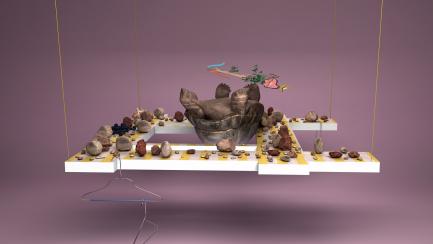Hirshhorn Exhibition “Suspended Animation” Opens Feb. 10, 2016
Roughly a century after the production of the first animated film, the Smithsonian’s Hirshhorn Museum and Sculpture Garden presents “Suspended Animation.” The exhibition, which opens Feb. 10, 2016, brings together six artists who use computer animation in their work: Ed Atkins, Antoine Catala, Ian Cheng, Josh Kline, Helen Marten and Agnieszka Polska.
“Technologically produced images increasingly influence and define our lives,” said Gianni Jetzer, the exhibition’s curator and the Hirshhorn’s curator-at-large. “The greater use of animation by artists mirrors directly this radical shift in our culture.”
The artists in the exhibition use digitally generated images as a tool to question conceptions of reality. Their immersive environments confront the viewer with the actualities of the digital age, such as the dissolution of privacy, the digitization of identity and the impact of a hyperreal virtual world on tangible physical experience.
Animation today, however, is radically different from its beginnings, where its aspiration was to “animate” still images, to bring them to life. Rather than aiming for vitality, the artists in the exhibition create animations that interrogate the image itself. The term “suspended animation” is used in science and science fiction to describe the replacement of natural animation by machines that control and secure vitality.
Rather than mimicking the real, animation now challenges human consciousness and aesthetic perception. Reality is no longer the benchmark for the imperfect image, but rather the animated image provides the measure for an imperfect reality.
About the Artists
Atkins (British, b. 1982, Oxford; lives and works in London) works mainly with computer-generated characters and scenes that are built upon self-performance and explore the creation of alternative notions of space and time. He has been the focus of major solo exhibitions at MoMA PS1, the Bonner Kunstverein and Tate Britain.
Catala (French, b. 1978, Toulouse; lives and works in New York) pairs animation with pneumatic sculptures and holograms, creating encounters that drift into the humorous but also investigate the edges of perception. He has had solo exhibitions at Musée d’Art Contemporain de Lyon and the Carnegie Museum of Art.
Cheng (American, b. 1984, Los Angeles; lives and works in New York) studied cognitive science at the University of California at Berkeley. In his live simulations, familiar objects are programmed with basic properties but are left to influence each other without authorial control. He has had solo exhibitions at the Kunsthalle Düsseldorf and the Sandretto Re Rebaudengo Foundation.
Kline (American, b. 1979, Philadelphia; lives and works in New York) draws inspiration from advertising, social media and the latest technological innovations. His sculptural installations reflect on digital transformations and their impact on the social and political sphere. He has a solo exhibition at Modern Art Oxford this summer.
Marten (British, b. 1985, Macclesfield; lives and works in London) creates animated objects and interiors whose artificial surfaces give them an uncanny presence. Voiceovers unrelated to the action onscreen add deliberately enigmatic explanatory undertones. Marten has had solo exhibitions at Palais de Tokyo, Paris; Kunsthalle Zürich and CCS Bard.
Polska (Polish, b. 1985, Lublin; lives and works in Warsaw) creates immersive, hallucinatory animations that exploit ambiguities of understanding in visual imagery, verbal language and science. She has had solo exhibitions at Nottingham Contemporary, the Salzburger Kunstverein and the Centre for Contemporary Art, Ujazdowski Castle.
For more information, visit hirshhorn.si.edu/collection/suspended-animation.
# # #
SI-285-2015






